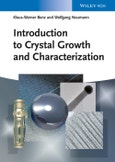Nucleation processes, their kinetics and main growth mechanism will be introduced in fundamentals of crystal growth. Some phase diagrams in the solid and liquid phases in correlation with the segregation of dopants are treated on a macro- and microscale. Fluid dynamic aspects with different types of convection in melts and solutions are discussed. Various growth techniques for semiconducting materials in connection with the use of external field (magnetic fields and microgravity) are described.
Crystal characterization as the overall assessment of the grown crystal is treated in detail with respect to
- crystal defects
- crystal quality
- field of application
Introduction to Crystal Growth and Characterization is an ideal textbook written in a form readily accessible to undergraduate and graduate students of crystallography, physics, chemistry, materials science and engineering. It is also a valuable resource for all scientists concerned with crystal growth and materials engineering.
Table of Contents
Preface ix
Acknowledgments xiii
1 Fundamentals of Crystalline Materials 1
1.1 Crystalline State 1
1.2 Fundamentals of Geometrical Crystallography 12
1.2.1 Crystal Lattices 12
1.2.2 Crystal Axes Systems, Crystal Systems, and Crystal Families 14
1.2.3 Crystal Faces and Zones 15
1.2.4 Indexing in the Hexagonal Crystal Family 24
1.3 Morphological Symmetry of Crystals 25
1.3.1 Crystallographic Point Groups 40
1.3.2 Some Basic Facts of Group Theory 52
1.4 Structural Symmetry 60
1.4.1 Crystal Lattices, Motifs, and Crystal Structures 60
1.4.1.1 Bravais Lattices 61
1.4.1.2 The Reciprocal Lattice 62
1.4.1.3 Lattice Transformations 68
1.4.2 Crystallographic Space Groups 71
1.4.2.1 General Remarks 72
1.4.2.2 The International Tables for Crystallography – The Reference Book for the Representation of Space Group Symmetries 76
1.4.2.3 Mathematical Description of the Space Group Symmetry 93
1.4.3 Generalized Crystallographic Symmetry 101
1.5 Crystal Structures 104
1.5.1 Sphere Packings 108
1.5.2 Selected Examples of Inorganic Structure Types 112
1.5.2.1 Polymorphism and Polytypism 124
1.5.3 Selected Examples of Molecular Crystals 126
1.5.4 Symmetry Relations between Crystal Structures 145
1.6 Crystallographic Databases and Crystallographic Computer Programs 152
Appendix: Supplementary Material S1 Special Crystal Forms of Cubic Crystal Classes 159
References 164
2 Basics of Growth Mechanism and Solidification 171
2.1 Nucleation Processes 171
2.1.1 Homogeneous Nucleation 175
2.1.2 Heterogeneous Nucleation 177
2.1.3 Metastable Zone Regime 179
2.1.4 Equilibrium Shape of Crystals 180
2.2 Kinetic Processes and Growth Mechanism 182
2.2.1 Molecular Kinetic Theory of Crystal Growth 183
2.2.2 Interfaces and Roughening of Surfaces 185
2.2.3 Vapor–Liquid–Solid (VLS) Mechanism 189
2.2.4 Crystal Growth from Ambient Phases on Rough Surfaces: Vapor Phase, Solution, and Melt Media 190
2.2.5 Crystal Growth on Flat Surfaces 193
2.3 Phase Diagrams and Principles of Segregation 195
2.3.1 Phase Diagrams with a Continuous Miscibility in the Solid and Liquid Phases 196
2.3.2 Segregation and Segregation Coefficients 201
2.3.3 Constitutional Supercooling and Morphological Stability 212
2.4 Principles of Flow Regimes in Growth Melts 214
2.4.1 Buoyancy Convection 215
2.4.2 Marangoni Convection 216
References 218
3 Growth Techniques in Correlation with Related Growth Mechanism 221
3.1 Overview on Main Growth Techniques 221
3.2 Principles of Melt Growth Techniques 224
3.2.1 The Czochralski Crystal Growth Process 224
3.2.2 Growth Method after Bridgman 234
3.2.3 The Float Zone Crystal Growth Process 244
3.2.4 Bulk Crystal Growth from Metallic Solutions 253
3.2.4.1 Traveling Solvent Method (TSM) 253
3.2.4.2 Traveling Heater Method (THM) 255
3.2.4.3 The Solute, Synthesis, Diffusion Method (SSD) 259
3.3 Bulk Crystal Growth of II–VI Compounds from the Vapor 260
3.3.1 Crystal Growth of CdTe by a Sublimation Traveling Heater Method, STHM, in Closed Ampoules 262
3.3.2 Crystal Growth of CdTe by the Markov Method in Semiclosed Ampoules 264
3.4 Epitaxial Growth Techniques 267
3.4.1 Liquid Phase Epitaxy (LPE) 270
3.4.2 Vapor Phase Epitaxy (VPE) 279
3.5 Supplementary Material: Principles of Verneuil Technique, Growth from High and Low Temperature, Nonmetallic Solutions 295
3.5.1 Verneuil Technique 295
3.5.2 Growth from High Temperature Solutions (Flux Growth) 295
3.5.3 Growth from Low Temperature Solutions (Aqueous Solutions) 296
References 298
4 Characterization of Crystals 301
4.1 Crystal Defects 302
4.1.1 Zero-Dimensional Defects 303
4.1.2 One-Dimensional Defects 314
4.1.3 Two-Dimensional Defects (Planar Defects) 326
4.1.3.1 Grain Boundaries 328
4.1.3.2 Stacking Faults 336
4.1.3.3 Antiphase Boundaries 340
4.1.3.4 Twins 342
4.1.3.5 Domain Boundaries 355
4.1.3.6 Crystal Surfaces 363
4.1.4 Three-Dimensional defects 368
4.1.4.1 Inclusions 369
4.1.4.2 Precipitates 370
4.1.4.3 Voids 374
4.2 Crystal Quality 375
4.2.1 Criteria of Crystal Quality 376
4.2.2 Crystal Quality and Application 378
4.3 Selected Methods of Crystal Characterization 382
4.3.1 Etching of Crystals 382
4.3.2 X-Ray Topography 383
4.3.3 Electron Microscopy 385
4.3.3.1 Scanning Electron Microscopy 387
4.3.3.2 Transmission Electron Microscopy 388
4.4 Materials Engineering by Correlation of Crystal Growth and Characterization 392
Anna Mogilatenko
4.4.1 Epitaxial Growth of GaN on LiAlO2 Substrates 393
References 408
Index 415







